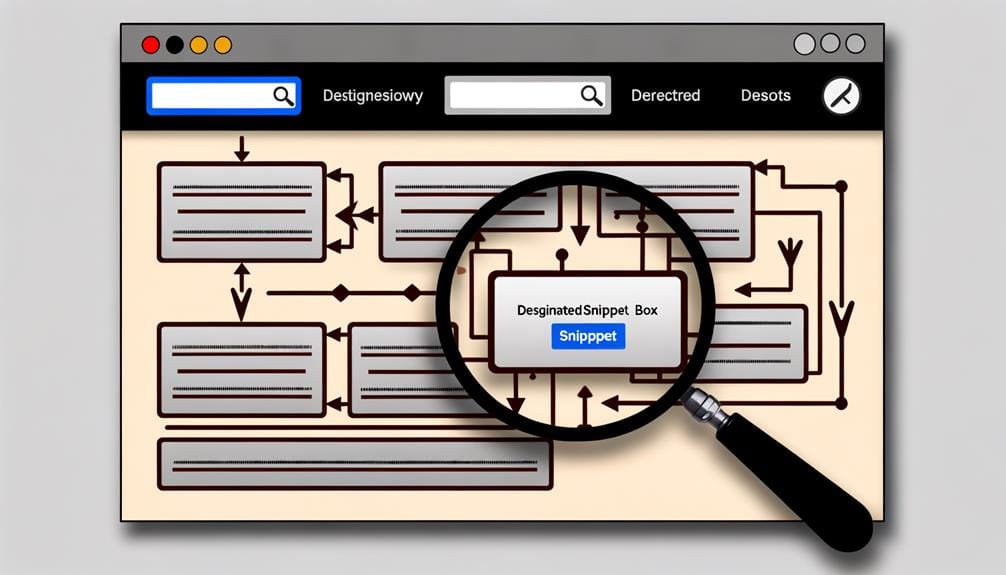You can optimize for featured snippets by starting with detailed keyword research, focusing on long-tail keywords with high search intent. Analyze competitors' snippets using tools like Ahrefs for insights. Match your content formatting to common snippet types such as paragraphs, lists, and tables. Structure content effectively using H2 and H3 headings and provide concise answers. Don't use first-person language; keep it objective. Optimize for various types of search intent and incorporate high-quality media like images and videos to engage users. Each of these strategies will significantly boost your snippet optimization results, offering deeper insights into maximizing SEO potential.
Key Takeaways
- Conduct detailed keyword research to identify long-tail keywords triggering featured snippets.
- Utilize competitor analysis tools to find and fill content gaps for snippet opportunities.
- Structure content with H2 and H3 headings, including concise answers to match snippet formats.
- Optimize content tone with a third-person, neutral, and objective voice for Google's preference.
- Use high-quality media like clear images, videos, and infographics to enhance engagement and snippet eligibility.
Keyword Research for Snippets
To effectively optimize for featured snippets, start by conducting detailed keyword research to identify long-tail keywords that frequently trigger these snippets. Use tools like Ahrefs to analyze search volume and competition for these keywords. Focus on long-tail keywords, as they often have lower competition and higher specificity, making it easier to rank for featured snippets.
Investigate informational keywords with high search intent. These keywords align with user queries that are looking for detailed answers, which is crucial for snippet optimization. Question-based keywords are particularly effective because they often trigger paragraph or list snippets. By targeting these types of keywords, you can create content that directly answers common user queries.
Understand the various snippet formats—paragraphs, lists, tables, and more. Tailor your content to align with these formats based on your keyword research. For example, if a question-based keyword frequently triggers a list snippet, format your content accordingly.
Analyze Competitors' Snippets

Analyzing your competitors' snippets can reveal valuable insights into keyword opportunities and content strategies that you can leverage to improve your own SEO efforts.
By using tools like Ahrefs, you can identify which keywords trigger featured snippets for your competitors. This data is crucial for guiding your optimization efforts and boosting your chances of winning featured snippets.
When you examine competitor snippets, you can uncover content gaps in your own material. These gaps represent untapped opportunities that you can capitalize on. By understanding the search intent behind these snippets, you can tailor your content more effectively to meet user expectations.
Additionally, competitor analysis provides insights into formatting preferences, which can further refine your content strategies.
For instance, if you notice that a competitor's snippet is frequently triggered by a particular keyword, you should consider optimizing your content around that keyword. This targeted approach can significantly enhance your chances of securing a featured snippet.
Furthermore, by analyzing multiple competitor snippets, you can identify commonalities and trends that can inform your broader SEO strategy.
Ultimately, a detailed, data-driven analysis of competitors' snippets is indispensable for any robust optimization effort aiming at winning featured snippets.
Match Snippet Formats
To increase your chances of landing a featured snippet, start by identifying the common snippet types like paragraphs, lists, and tables that Google prefers.
Tailor your content structure to match these formats precisely, ensuring it aligns with user search intent.
This data-driven approach can significantly enhance your visibility and boost your search rankings.
Identify Common Snippet Types
Understanding the common types of featured snippets—paragraphs, lists, tables, and videos—can significantly enhance your SEO strategy and improve search visibility.
Paragraph snippets, which account for 70% of all featured snippets, are perfect for concise answers or definitions. This type of featured snippet optimization involves crafting clear, direct responses to common queries.
List snippets, whether ordered or unordered, present information in a format that's easy to scan and digest. They're particularly useful for 'how-to' guides or steps in a process.
To identify common snippet types that work best for your content, analyze the current search results for your target keywords.
Table snippets display data in a tabular format, making them ideal for structured information like pricing, schedules, or comparison data. When optimizing for this snippet format, ensure your tables are well-organized and easy to read.
Video snippets offer engaging visual content directly in search results. These are highly effective for tutorials, demonstrations, and other visually-rich topics.
To optimize for video snippets, use clear titles, descriptions, and structured data.
Tailor Content Structure
Adapting your content structure to align with the format of existing snippets can significantly boost your chances of securing a featured snippet, enhancing your search visibility and driving more targeted traffic. To start, analyze the snippet formats currently dominating your target keywords and model your content accordingly. This step is crucial in optimizing content for higher visibility.
Using a hierarchical structure with clear, concise headings can greatly improve your chances. Break down your content into well-defined sections, ensuring each topic is addressed concisely and clearly. Avoid first-person language, as it can reduce the suitability of your content for featured snippets.
Defining topics with precision is another key factor. Ensure each section of your content addresses a specific query or subtopic directly, which helps in outperforming competitors. For instance, if list snippets are prevalent, format your content into bullet points or numbered lists.
This results-focused approach ensures your content isn't only informative but also primed for SEO optimization. By tailoring your content structure to match snippet formats, you enhance the likelihood of being featured, ultimately driving more organic traffic and improving your search engine rankings.
Structure Content Effectively

Effective structuring of your content with H2 and H3 headings significantly boosts your chances of capturing featured snippets. Start by using H2 and H3 headings to break down your content into digestible sections. Aim for concise answers of around 50 words under each header to improve your chances of being featured. Incorporate how-to phrases in FAQs to enhance your content structure, making it easier for search engines to identify and feature your content.
Analyze competitor snippets to understand how they structure their content. This allows you to organize your information similarly but with improved optimization. Use relevant keywords and phrases to target specific search queries, ensuring that your content aligns with what users are searching for. Your content should be optimized not only for readability but also for SEO.
Here's a quick breakdown:
| Strategy | Action |
|---|---|
| Use H2 and H3 headings | Break down content into sections |
| Provide concise answers | Keep responses around 50 words |
| Incorporate how-to phrases | Use in FAQs for better structure |
| Analyze competitor snippets | Organize content based on competitors |
| Optimize with keywords | Target specific search queries with relevant keywords and phrases |
Avoid First-Person Language

To optimize for featured snippets, you should avoid using first-person language, as it helps maintain an objective tone.
Adopting a third-person voice can enhance your chances of winning a featured snippet, aligning better with Google's preference for factual, neutral content.
Maintain Objective Tone
Avoid using first-person language in your content to enhance the likelihood of winning SEO featured snippets. First-person narratives can hinder your chances, as Google favors neutral and informative content. By maintaining an objective tone, you provide clear and concise information, aligning with Google's guidelines for featured snippets.
When crafting your content, focusing on an objective tone is essential. This tone ensures the information presented is perceived as professional and trustworthy. An informative and neutral approach increases your content's optimization potential for featured snippets.
Here's a quick comparison to illustrate the impact of different tones:
| Tone Type | Effect on SEO Featured Snippets |
|---|---|
| First-Person | Reduces chances, appears subjective and personal |
| Second-Person | Engages readers, but not as neutral as objective tone |
| Objective Tone | Increases chances, aligns with Google's preference |
| Informative | Provides valuable information, highly effective |
| Professional | Enhances credibility, aligns with featured snippet goals |
Use Third-Person Voice
Implementing a third-person voice in your content directly aligns with search engine preferences and significantly boosts your chances of securing featured snippets. First-person language can hinder your chances of winning these coveted spots, as Google featured snippets favor a neutral tone and third-person perspective.
By focusing on snippet optimization through the use of third-person voice, you're more likely to match the format and style required for snippet optimization success.
When optimizing for featured snippets, consider these key points:
- Search Engine Preferences: Third-person voice aligns better with how search engines evaluate content for snippets.
- Neutral Tone: A neutral tone avoids subjectivity, making the content more suitable for a wide audience.
- Format and Style: Third-person voice matches the format and style typically found in Google featured snippets.
- Snippet Optimization Success: Using third-person language increases your chances of snippet optimization success.
Optimize for Search Intent

Understanding search intent is essential for crafting content that not only meets user needs but also maximizes your chances of securing a featured snippet. When you optimize content for search intent, you're aligning it with the exact information users are seeking through their search queries. This approach not only boosts your position at the top of Google's search results but also drives organic traffic to your site.
To achieve this, start by analyzing the different types of search intent—informational, navigational, transactional, and commercial. Tailor your content to address these intents explicitly. For instance, if users are looking for 'how-to' guides, ensure your structured content provides detailed, step-by-step instructions. This alignment increases your chances of being featured in snippets and can significantly improve visibility and click-through rates.
Use tools like Google Analytics and Search Console to identify the search queries that bring users to your site. By understanding user intent behind these queries, you can refine your content to better match their needs. Remember, the goal is to address search intent comprehensively, enhancing not just snippet eligibility but also providing valuable information that keeps users engaged.
Use High-Quality Media

Incorporating high-quality media like images and videos into your content can significantly increase your chances of securing a featured snippet, as over a third of them include visuals. High-quality visuals not only captivate readers but also improve user engagement, which is crucial for boosting your SEO efforts.
Here's how you can use media effectively:
- Images and Videos: Use clear, relevant images and videos to enhance content and make it more engaging.
- Videos with Transcripts: Adding transcripts to your videos can improve accessibility and increase the likelihood of being featured.
- Multimedia Elements: Incorporate a mix of images, infographics, and videos to cater to different learning styles and keep your audience interested.
- Canva: Utilize tools like Canva to create visually appealing graphics that can boost conversion rates and contribute to better SEO.
Frequently Asked Questions
How to Optimize for Featured Snippets?
To optimize for featured snippets, use question formats and concise content length. Implement heading tags, schema markup, and internal linking. Ensure authoritative sources, address user intent, optimize for mobile, include image alt text, and improve load speed.
Are Featured Snippets Good for Seo?
Are featured snippets good for SEO? Absolutely! They enhance user experience, especially with voice search and mobile optimization. Focus on content quality, competitive analysis, long tail keywords, schema markup, semantic search, answer boxes, and search intent.
How to Rank in Google Featured Snippets?
To rank in Google featured snippets, structure your content with clear headings, use question format, include lists and data tables, utilize schema markup, target specific keywords, optimize meta descriptions, and focus on user intent with precise answer boxes.
Does Rich Snippets Improve Seo?
Yes, rich snippets improve SEO by enhancing user experience, aligning with search intent, and increasing click-throughs. Implement schema markup and structured data for various content types, use meta descriptions, and conduct keyword research to boost organic traffic.
Conclusion
In optimizing for SEO featured snippets, remember that 70% of snippets come from pages ranking in the top five positions. By following these seven strategies, you can significantly increase your chances of capturing these prime spots.
- Focus on detailed keyword research, analyzing competitors, and matching snippet formats.
- Structure your content effectively and avoid first-person language.
- Optimize for search intent and incorporate high-quality media.
Implementing these tactics will enhance visibility and drive better results for your site.

